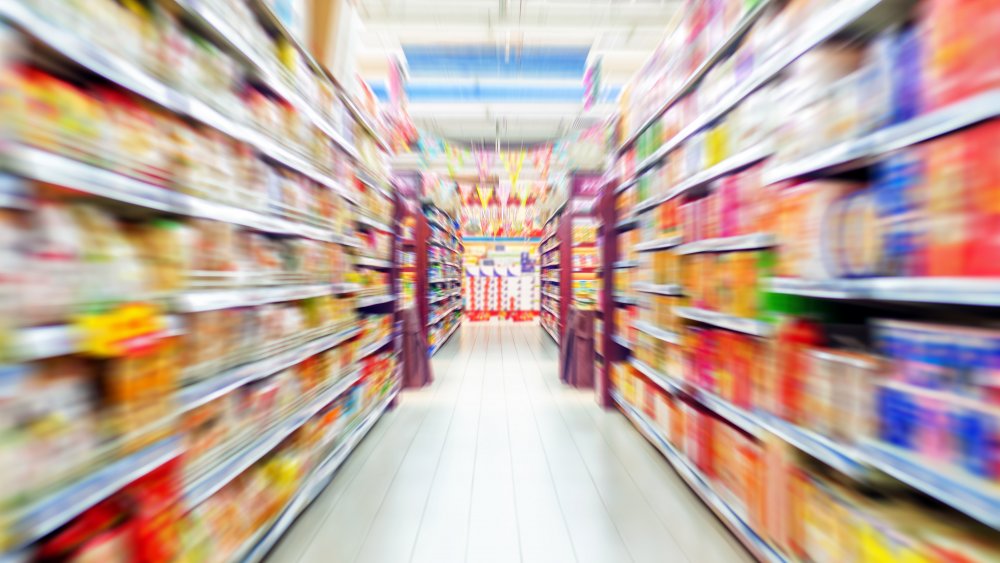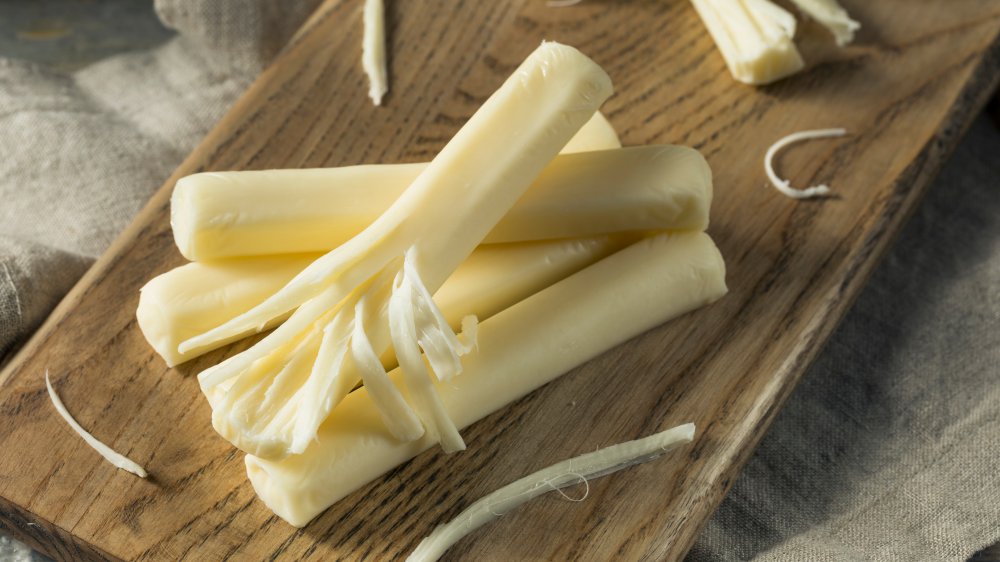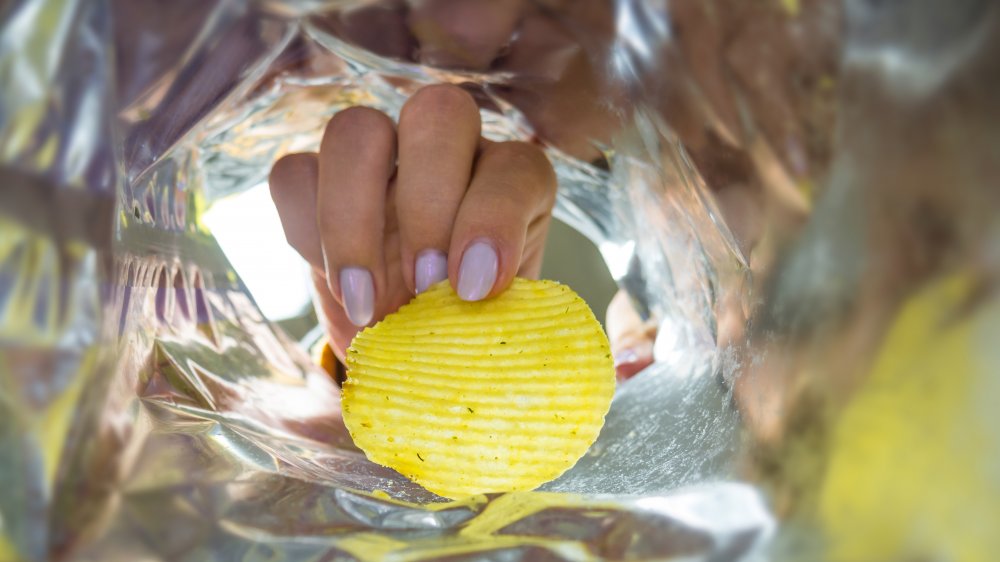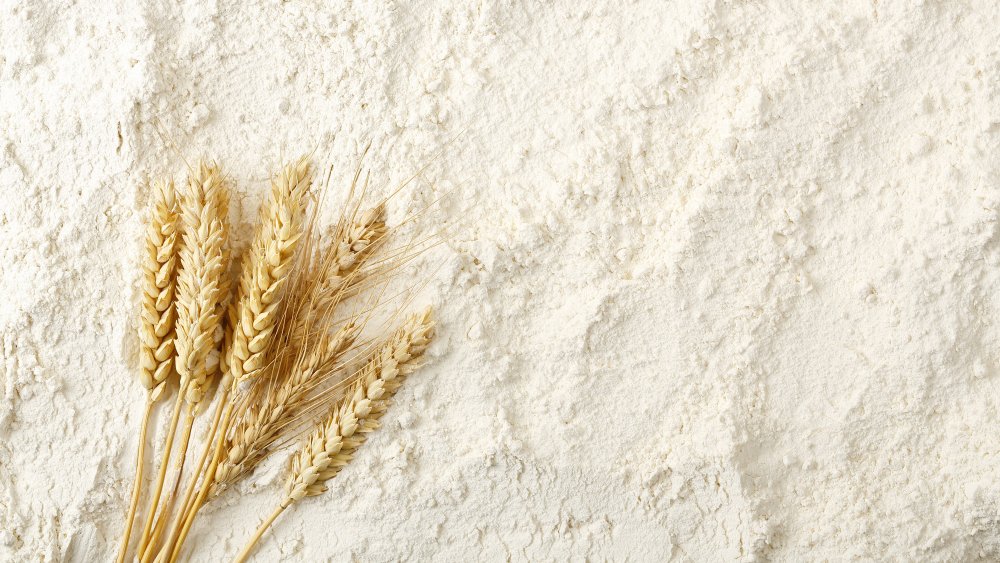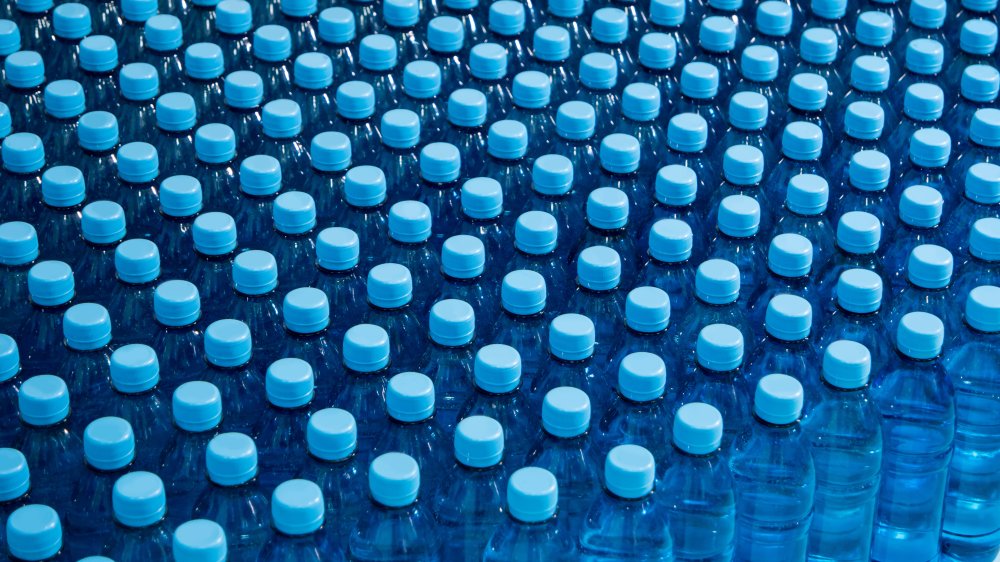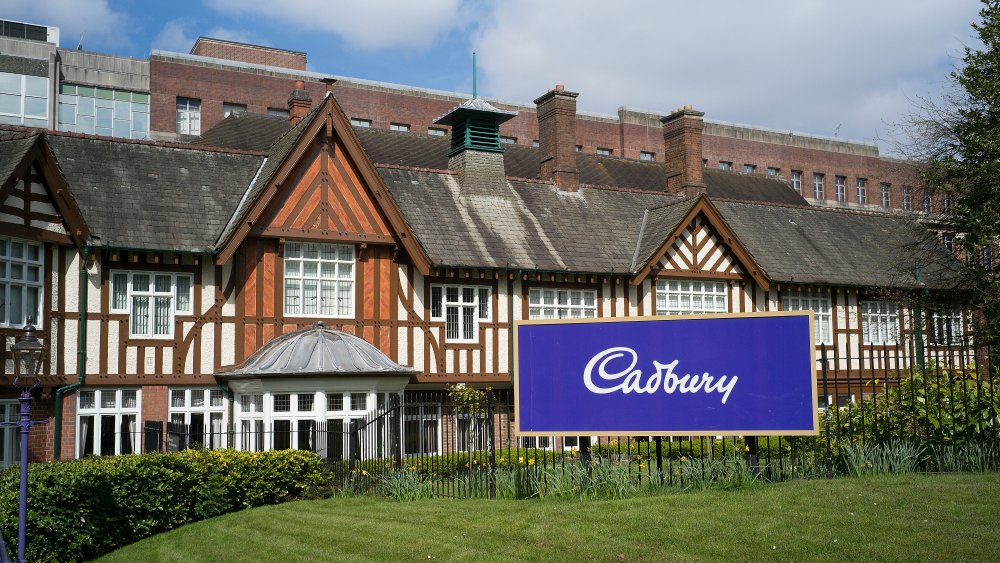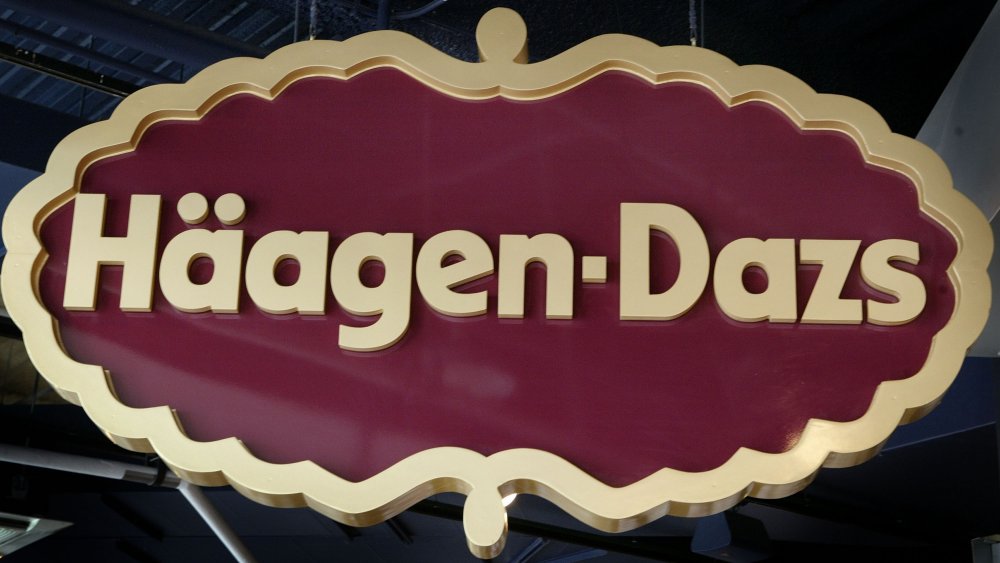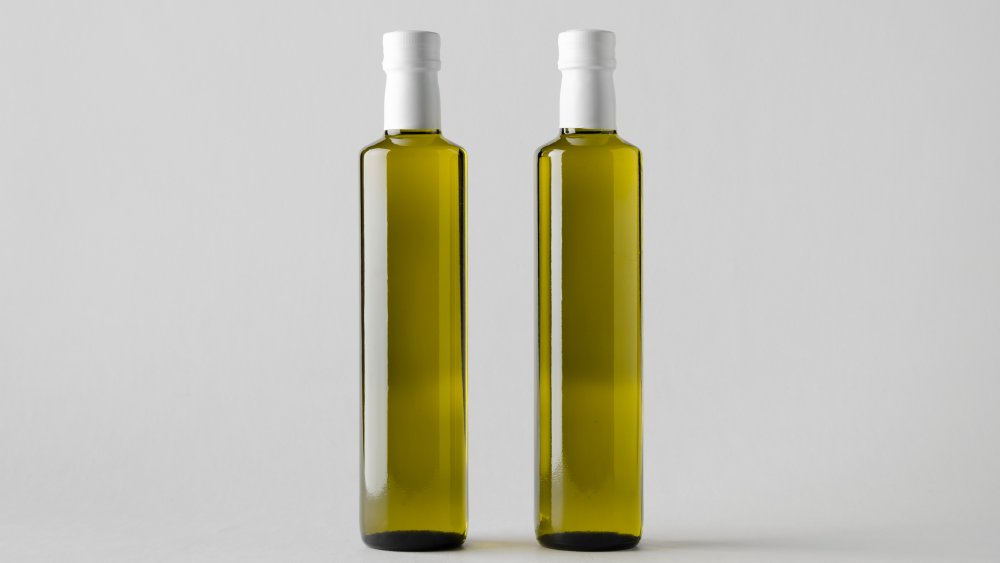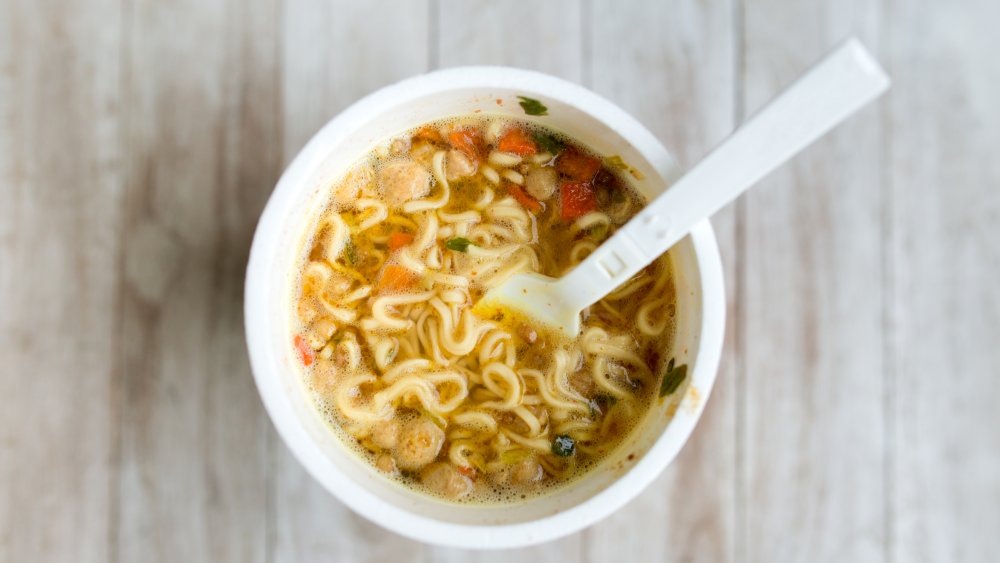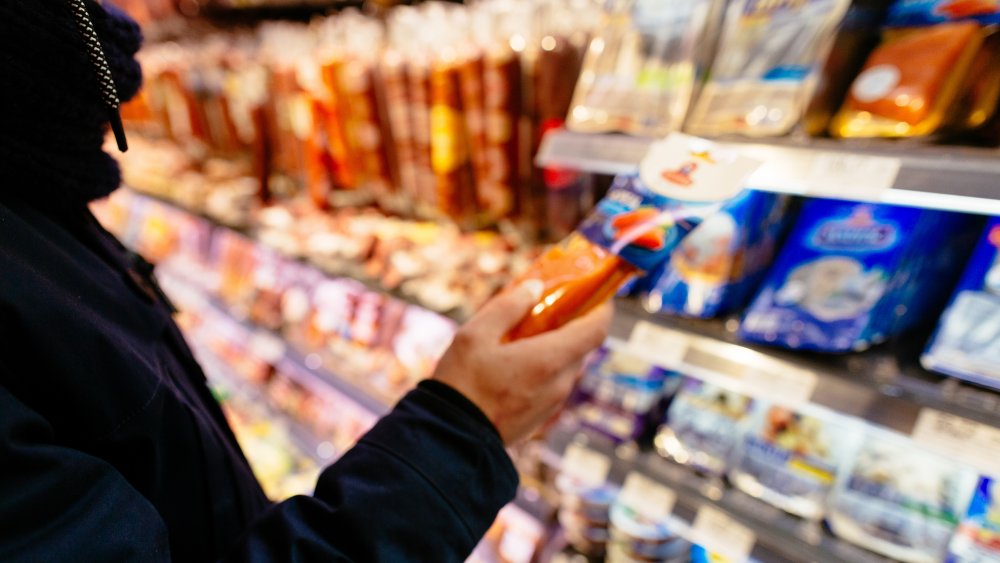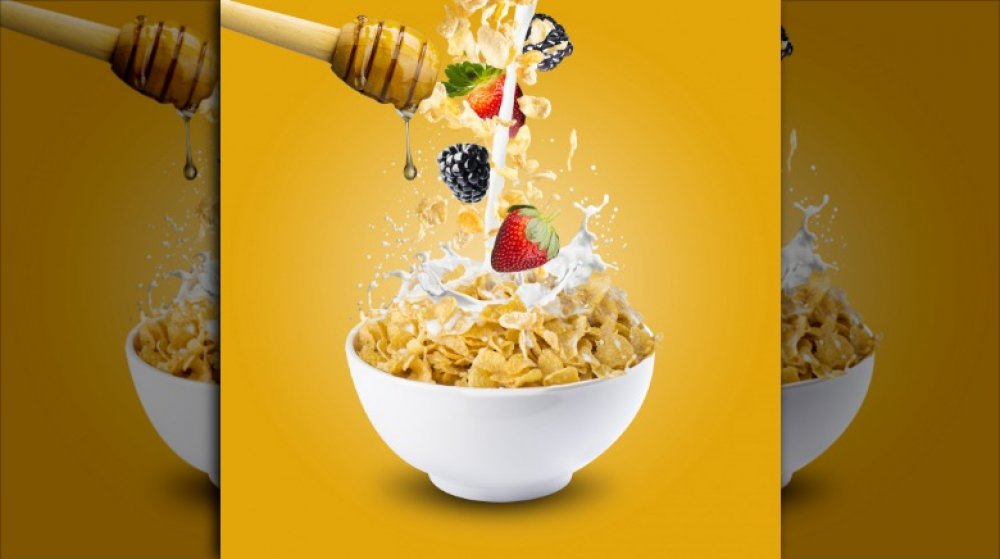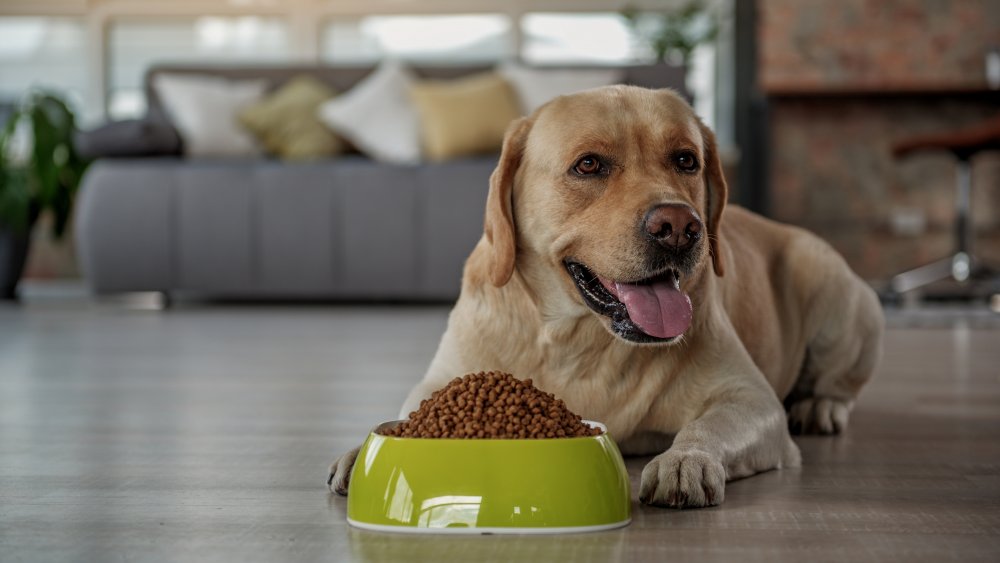Tricks Food Brands Use To Rip You Off
It's safe to say that food brands aren't disappearing into the ether anytime soon. Even if a giant nuclear spider was to destroy all of humanity tomorrow, the husks of our Coca-Cola cans and our empty bags of Flamin' Hot Cheetos would remain tethered to this earth for a long time. Michael Ruhlman, author of Grocery: The Buying and Selling of Food in America, told MarketWatch, "There used to be, as late as the 1990s, 7,000 items in a grocery store, and now it's 40,000 to 50,000."
But unfortunately, not every brand will sell its products in an honest manner. Some items have sneaky, weaselly words on their packaging that may fool you into buying products you'd be better off skipping. Other low-grade goods are designed to copycat other brands, and still other items have oversized packaging. But maybe worst of all, there are products that straight-up lie to your face.
If reading this intro has made you want to throw your rewards cards into the ocean, then please hold your metaphorical horses because this article will unpack a ton of ways that food brands may try to trick you into purchasing a rip-off. Hopefully, by the end of this article, you'll become a wiser consumer.
Some food brands put irrelevant facts on their packaging
Most packaged food that you buy at a supermarket is covered in words. A lot of these units of language are useful and can help you make informed purchasing decisions. Like, it's a good thing that these items have to list their ingredients. However, the food brands that make these products may slap some extraneous and slick info onto their boxes.
One product that has irrelevant facts on its packaging is an Australian cheese called Bega Stringers. According to The Conversation, this product's plastic exterior advertises that it's all natural and has no artificial colors and flavors. But the same thing can be said about most cheeses. It's worth noting a packet is fairly expensive and costs more than five Aussie dollars. If you were to buy this product instead of a cheaper cheese because of these claims, then you're potentially spending more than is necessary.
Bega Stringers isn't the only food company that stars perfunctory knowledge on its packaging. Just keep this in mind the next time that you're reading a product's claims.
Some food brands fill chips with mostly air
Most unopened packets of chips look incredibly plump, like they're brimming with Friday-night snacks. But if you were to open such a bag, you'd probably find that it wasn't filled with as many chips as you could eat and was instead ballooned with unbranded emptiness. Mental Floss stated that these bags are filled up with nitrogen.
But how much of different food brands' chip packs are inflated with this air? Well, artist Henry Hargreaves decided to find out. He told the BBC, "Over the years of being a consumer and buying crisps, I was constantly being disappointed with the value for money. And eventually I snapped."
Hargreaves made a YouTube video that breaks down how he discovered the amount of nitrogen that's in a packet of chips. He says, "I took a bag of chips and put it in a jug of water and measured the displacement. I then did what's kind of the most efficient way to package chips, which is vacuum-seal it and measured the displacement from that. I then crunched the numbers to figure out the percentages of, you know, how much chip there was to air ratio."
According to Hargreaves' research, a bag of Doritos is 86 percent air. Lay's were also 86 percent air, and Pringles were 66 percent air. This champ put it best in his BBC interview: "Packaging and the display of food has become an illusion and a fantasy."
Most branded flours and sugars from food brands hide a major fact
If you're buying a food brand's product at a premium price, then you're probably expecting that it's a higher-quality item. After all, if it costs more, then it has to be better. And at the very least, it can't be essentially the same thing as a generic version. Right?
The Kitchn claimed that brand-made flours, sugars, and salts typically have the same taste and texture as their generic counterparts. Furthermore, a 2015 study found that chefs typically spend 77 percent of their salt, sugar, and baking soda money purchasing store brands. Considering that chefs professionally work with these ingredients, you'd probably assume that their expertise would inform what pantry staples they'd bankroll.
Unsurprisingly, many branded baking ingredients, if not all of them, don't advertise if their product is almost identical to a competitor's cheaper version. It would truly be jaw-dropping to see a premium flour packet that said, "This pulverized wheat is the same as the generic stuff, but it has a fancier label. Please buy our pricey brand instead."
Look, if a company is shilling overpriced pantry staples, they're not lying if they omit to tell you that there are cheaper yet similar products on the market. That being said, this business wouldn't be giving you the whole story. If you're buying branded flour, sugar, or salt that's practically the same as a generic version because you think that it's superior, then you're definitely being fooled.
That bottled water from your favorite food brand may not be that special
The statistics company Statista revealed that in 2018, bottled water production made more than $18 billion in the U.S. alone. This figure is mind-boggling. One would probably hope that this liquid gold was coming from a glacier farm in the Swiss Alps instead of essentially coming straight from the tap. But sadly, such an ice acreage doesn't exist — plus, a decent amount of bottled water is made using the tap stuff.
A scientist named Peter Gleick ended up discovering what percentage of bottled water has tap water in it. In a tweet, he announced, "45 percent of all U.S. bottled water originates as tap water." Mother Jones also reported on Gleick's findings, which noted that around a mere 55 percent of bottled water really comes from springs.
In a different tweet, Gleick outlined the price difference between typical bottled water and tap water. Bottled water can cost $8.00 per gallon, and tap water can cost $0.004 per gallon. Therefore, if we buy food brands' H20 that contains the tap stuff, then we're being had. Moreover, we should ask ourselves if bottled spring water is honestly worth such a mark up.
Food brands have 'shrinkflated' their products
Sometimes, a food brand's product will shrink in size while its price stays the same. Likewise, we live in a world where we need a term to describe this crummy practice, and thus, we have the word shrinkflation. If your favorite $3.00 bag of gumdrops was once 18 ounces and it's now it's 16 ounces, then you already know why this is a travesty.
In July of 2020, BBC reported that Cadbury reduced the weight of its UK chocolate bar multipacks without lowering the price. To be expected, a ton of consumers weren't happy with this decision and took their grievances to Twitter. Vaseem Khan wrote, "If they shrink them anymore they won't be bars they'll be chocolate buttons." Nick Heath responded, "Well, that's Friday ruined."
If a company shrinkflates a branded product without lowering its price, then it's negatively impacting its consumers. These patrons will be paying the same amount of money for an item that's objectively less cost-effective, and that's just downright shady.
Food brand Haagen-Dazs' pints aren't a pint
A U.S. liquid pint is 16 ounces. It's not 15 ounces, nor is it 17 ounces. Sure, other pints with different proportions exist, but an American liquid pint is 16 ounces, right on the nose.
In 2009, Ad Age wrote that Haagen-Dazs was downgrading its ice cream pints from 16 ounces to a non-pinty 14 ounces. Yet, despite the fact that 14 ounces isn't a standard pint size, the company decided to keep using the word "pint." Haagen-Dazs said that it reduced its container's proportions because costs had risen. But be that as it may, they should've stuck to making ice cream instead of trying to redefine what a word means.
That same year, food brand Ben & Jerry's took a swing at Haagen-Dazs for making this move. The company published a feature that said it's wrong to reduce a pint's size and that they wouldn't follow suit. This piece didn't seem to affect Haagen-Dazs' decision, as the brand is still selling "pints" on Amazon that are apparently 14 ounces. "If I remember it correctly, a pint contains 16 ounces, not the 14 ounces of this 'pint' container," wrote one reviewer. Another said, "Stop lying! It's not eight 'pints.' It's eight 14 oz containers."
Look, Haagen-Dazs shrinkflated this product. CNBC stated that these cartons didn't drop in price. However, the company took its sketchy behavior to another level when it kept classifying these tubs as "pints." Don't let brands modify our nouns.
The olive oil from your favorite food brand may be lower-grade than it seems
Olive oil scams have been going on for a long time. The New Yorker detailed that even Ancient Rome had its dodgy merchants. These fraudsters would mix premium olive oil with lard or other less-pricey items. It would be amazing if these scams stopped once the empire fell, but that just isn't the case.
In a 2007 interview for the program All Things Considered, the host Michele Norris asks journalist Tom Mueller why customers should be wary of food brands' "extra-virgin olive oil"-labeled bottles. Mueller says that these products could contain other ingredients. He responds, "There are various types of misleading and fraud going on. The simplest kind is simple substitution with cheap seed oils — soybean oil, sunflower seed oil, canola oil, and that sort of thing. And that's typically kind of a mom-and-pop fraud operation when people rent a warehouse, blend and bottle, and sell their fake oils very, very quickly."
During the intervening years since this Mueller interview took place, it seems the oil olive situation hasn't improved. As stated by Food & Wine, the National Consumers League discovered that around 50 percent of all olive oils on store shelves had misleading labels in 2015 and 2019. The league's CEO Sally Greenberg said, "It's economic and food fraud because you can't be sure unless you're a very well informed consumer that a bottle labeled 'extra virgin olive oil' is actually that very high quality."
MSG-free food brands aren't actually safer
MSG is a delicious ingredient. MasterClass outlined that it's a food additive that provides a savory umami flavor. Furthermore, MSG isn't dangerous. Dr. Ken Lee said in a SciFri article, "It's wacko, it's weird; it's not true that MSG has any kind of toxic or causative role in food allergies."
Stefan Chin additionally expresses in a SciShow video, "While our love of MSG comes from biology, a lot of people's aversion to it seems to have roots in something else entirely: racism." Chin then explains that in 1968, a person wrote into The New England Journal of Medicine and claimed that Chinese food gave them heart palpitations and some other symptoms. They called this fake illness Chinese Restaurant Syndrome. "The idea took hold, spurring years of biased science based on a flawed assumption that Chinese Restaurant Syndrome was a real thing and that MSG caused it."
But while MSG is safe, some food brands still boldly market their products as MSG-free. In 2016, Paste said that Cup Noodles was removing the MSG from all of its soup flavors. In a photo of a Cup Noodles' container published alongside this article, you can see the updated packaging features a blue seal that declares, "NO ADDED MSG."
Brands should tell their consumers that MSG is a safe ingredient. They shouldn't potentially capitalize on irrational fears. If someone's buying an MSG-free product because they think that it's inherently healthier or less dangerous, then they're being misled.
Some food brands label fish incorrectly
When you buy a can of yellowfin tuna, you're probably expecting a can of yellowfin tuna. And you're most likely wanting it not to contain a mystery fish that isn't mentioned on the label. However, depending on where you live in the world, there's a chance that you're getting such a product.
Back in 2018, a study discovered that a percentage of tuna is being mislabeled across six European countries. The research team for this paper collected and analyzed 545 samples of tuna from Spain, Portugal, France, Ireland, the UK, and Germany. The researchers discovered that 6.7 percent of the fresh and frozen tuna products that they looked at were mislabeled. They additionally revealed that 7.84 percent of their canned tuna samples were mislabeled as well.
Another country that's sold mislabeled fish is the U.S. A 2013 Oceana study collected over 1,200 seafood samples from 674 retailers in 21 different states. The organization reported that 33 percent of the samples it DNA-tested were mislabeled. Furthermore, 87 percent of the snapper and 59 percent of the tuna it tested was mislabeled.
It would be a surprise and a half if a seafood brand was labeling its products incorrectly on purpose. But a can of fish that contains the wrong fish is lying. These sorts of errors can dupe grocery shoppers into getting a bad deal.
Copycat food brands could swindle you into buying them
Have you ever picked up a packet of Doritos, gotten home, and then released you've actually purchased a knock-off instead? Well, if this hypothetical sings to you, you're possibly not alone. British Brand Group and GlaxoSmithKline co-funded a study to see if customers were able to distinguish a real food brand from a copycat. This paper said that shoppers mistook the fake brand for the real one 20 percent of the time when both were presented together. Moreover, the participants thought that the copycat was legit 64 percent of the time when the branded product wasn't displayed.
And unfortunately, a knockoff-brand may not be as good as the real deal. Tim Burrowes wrote a piece for Mumbrella about how he accidentally bought a Kellogg's Crunchy Nut clone. Yup, instead of getting the nectarous original, he got an Aussie copycat called Honey Crunch. Both of these packages were golden yellow, featured a honey stick drooped in syrup, and had cornflake-esque cereal splashing in an oasis of milk. But even though both products share these outward-facing characteristics, this blunder embarrassed Burrowes. This is because he thought that the knockoff tasted worst, and selecting it made him look "naive."
If you've bought a branded lookalike believing it was the genuine article but it's not as appetizing, then you've been taken for a ride.
Dog foods brands can trick you with words like 'gourmet'
Human food isn't the only branded product that may maneuver you into buying a dud. That's right, the meals that our puppers, our good boys, and our woofers need can be overpriced too. As a case in point, let's take a look at what Reader's Digest had to say about gourmet dog food brands. In January of 2020, they wrote an article that said gourmet dog food is exactly the same as any other type of dog food. This is because there's no criteria to define what gourmet means in this context.
The abovementioned adjective craftily implies that this dog food is somehow different from all the non-gourmet products on the market. Therefore, such a word could potentially bamboozle an uninformed customer into thinking it's superior in some way. And some of these brands are more expensive than the generic stuff. If you want to look after your pupper, you don't need to purchase the bougiest of brands.
